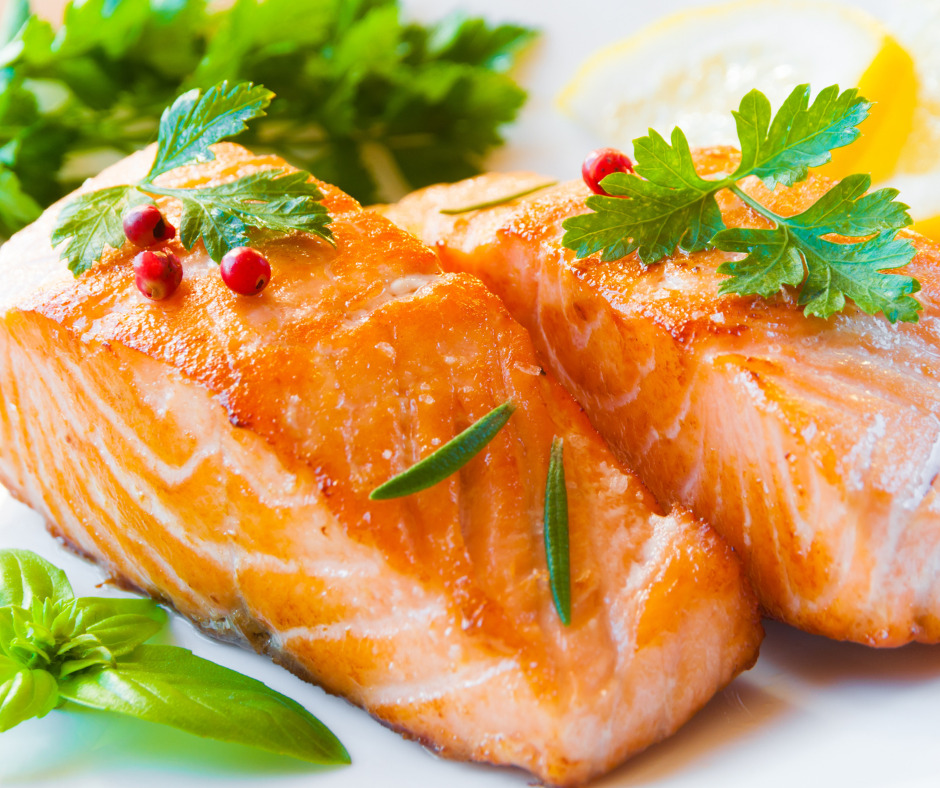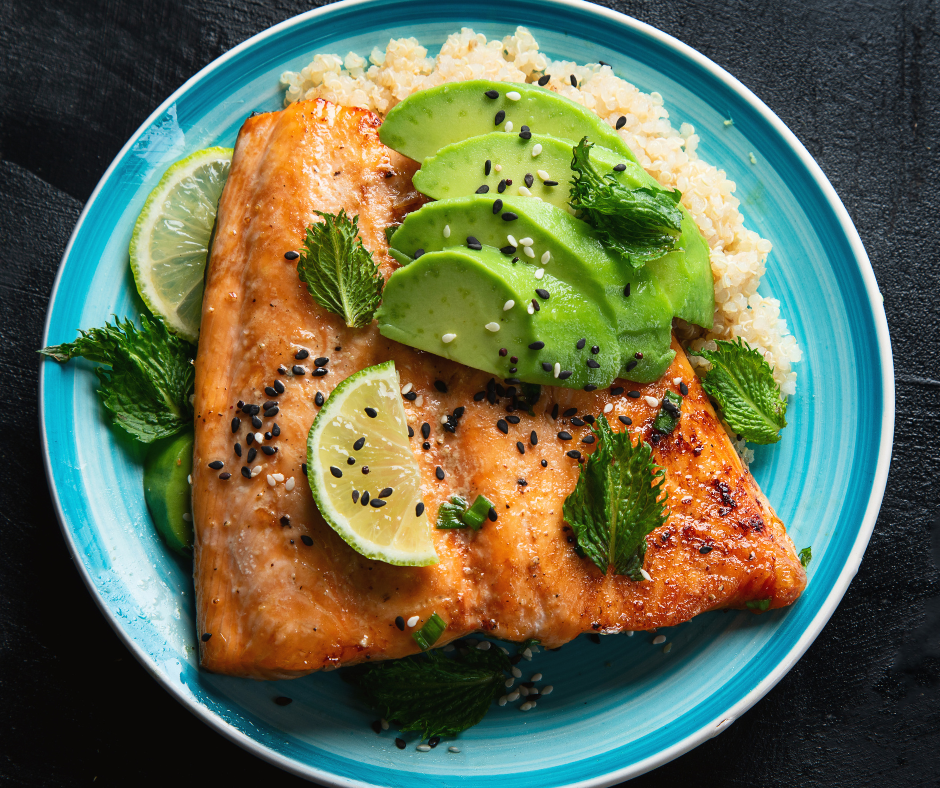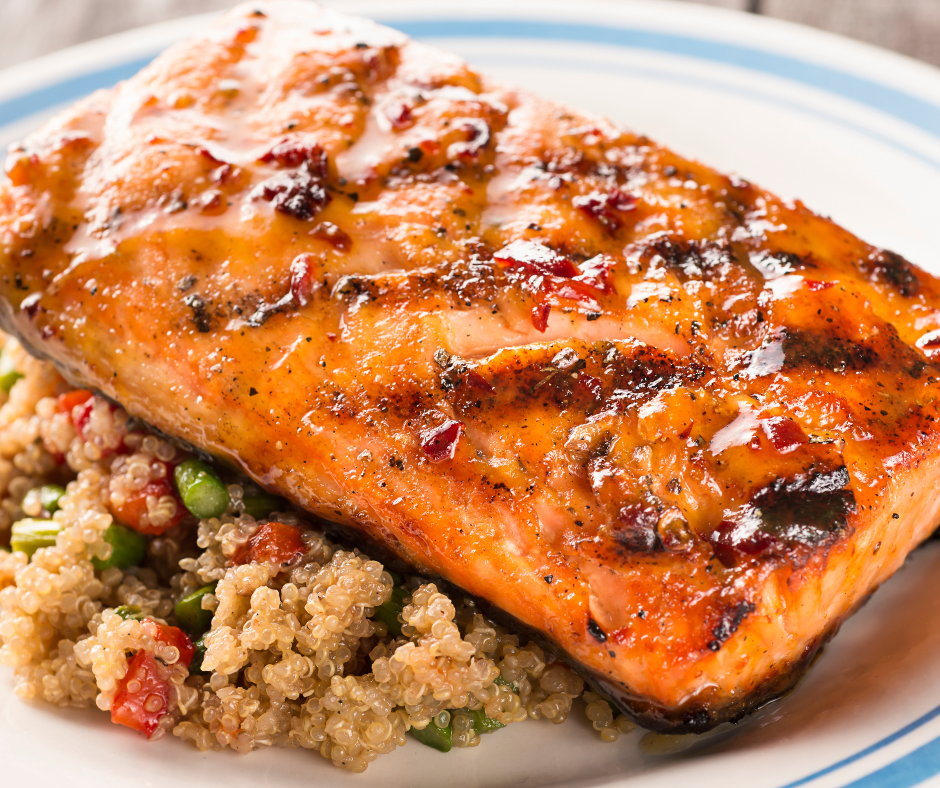Introduction
Properly storing cooked salmon is crucial to maintaining its freshness and safety. Whether you have leftovers from a delicious meal or plan to use them for meal prep, knowing ‘How Long Does Cooked Salmon Last in the Fridge?’ is essential. This article will explore the importance of proper storage for cooked salmon and the benefits of using leftovers for meal prep.

The Importance Of Proper Storage For Cooked Salmon
Cooked salmon, like any other perishable food, can spoil if not stored correctly. Improper storage can lead to bacterial growth, which can cause foodborne illnesses. To ensure the longevity and quality of cooked salmon, it is essential to follow these storage tips:
- Refrigerate promptly: As soon as you finish your meal, refrigerate any leftovers within two hours. Bacteria thrive at temperatures between 40°F (4°C) and 140°F (60°C), so it’s important to minimize the time salmon spend in this temperature danger zone.
- Store in an airtight container: Transfer cooked salmon to an airtight container or wrap it tightly in plastic or aluminum foil. This helps prevent moisture loss and keeps out unwanted odors from other foods in the fridge.
- Place in the coldest part of the fridge: Store the cooked salmon in the coldest part of the refrigerator, usually the back or the bottom shelf. This ensures a consistent temperature and helps maintain the fish’s quality.
- Don’t keep for too long: Cooked salmon stored in the fridge is best consumed within three to four days. Beyond this timeframe, the quality and flavor may start to decline.
Benefits Of Using Leftovers For Meal Prep
Leftover cooked salmon can be a great addition to your meal prep routine. Here are some benefits of using leftovers for meal prep:
- Saves time and money: By utilizing leftovers, you can save time and money by avoiding cooking an entirely new meal. Cooked salmon can be easily incorporated into salads, sandwiches, or grain bowls for lunches or quick dinners.
- Increases nutrient intake: Salmon is a nutrient-dense food rich in omega-3 fatty acids, protein, and vitamins and minerals. Incorporating leftover salmon into your meals can increase your nutrient intake and make your meals more wholesome.
- Enhances flavor: Cooked salmon develops more flavor as it sits in the fridge, making it even more delicious when used in meal prep. The flavors from herbs, spices, and marinades have more time to meld together, resulting in a tastier dish.
- Promotes portion control: With pre-portioned leftovers, you can easily control your serving sizes and avoid overeating. This can be beneficial for those trying to maintain or lose weight.
In conclusion, properly storing cooked salmon is essential for maintaining its freshness and ensuring it remains safe. Following the recommended storage tips and utilizing leftovers for meal prep, you can enjoy delicious and nutritious salmon dishes while minimizing waste and saving time. So, the next time you have leftover cooked salmon, don’t hesitate to incorporate it into your meal prep routine for a convenient and satisfying meal.
Storage Guidelines For Cooked Salmon
How Long Does Cooked Salmon Last in the Fridge?
When storing cooked salmon in the fridge, it is crucial to follow food safety guidelines to ensure its freshness and safety. So, How Long Does Cooked Salmon Last in the Fridge? Cooked salmon can generally last 3-4 days in the refrigerator when properly stored and handled. However, it’s important to note that the storage time can vary depending on factors such as the quality of the salmon, how it was cooked, and the storage conditions. To maintain the best quality and flavor, consuming cooked salmon within 1-2 days is recommended.
It’s worth mentioning that salmon is a highly perishable food, so it’s essential to refrigerate it promptly after cooking. Leaving it at room temperature for over 2 hours can increase the risk of bacterial growth, leading to foodborne illnesses. Therefore, cooling the salmon to room temperature within 2 hours of cooking and then transferring it to the refrigerator is crucial for food safety.
Cooling Cooked Salmon To Room Temperature Before Refrigeration
After cooking salmon, it’s important to allow it to cool to room temperature before refrigerating. Placing warm or hot salmon directly in the fridge can lead to condensation inside the container, creating a moist environment that promotes bacterial growth. Let the cooked salmon sit at room temperature until it cools down to prevent this. This cooling process helps maintain the quality and safety of the salmon.
Once the salmon has cooled, it’s time to store it properly in the fridge. The first step is ensuring the salmon is properly wrapped or stored in an airtight container. This prevents exposure to air and other contaminants, maintaining the freshness of the fish. Wrapping the salmon tightly in plastic wrap or aluminum foil is a common way to protect it.
Next, placing the cooked salmon in the coldest part of the refrigerator is essential. The coldest areas are usually the back or the bottom shelf. This location ensures a consistent and low temperature, which helps inhibit the growth of bacteria and maintain the quality of the salmon.
In addition to proper wrapping and refrigeration, it’s important to adhere to the recommended storage time. As mentioned, cooked salmon is best consumed within 3-4 days of refrigeration. Beyond this timeframe, the quality and flavor may start to decline, and there is an increased risk of foodborne illnesses. Therefore, it’s advisable to plan your meals accordingly and avoid keeping cooked salmon in the fridge for too long.
By following these storage guidelines, you can ensure that your cooked salmon remains fresh, safe to eat, and retains its quality. It’s worth noting that these guidelines apply specifically to cooked salmon. Raw salmon has different storage guidelines and should be handled separately to prevent cross-contamination and foodborne illnesses.
In conclusion, properly storing cooked salmon in the fridge is essential for maintaining its freshness, safety, and flavor. By cooling the salmon to room temperature before refrigerating, using proper wrapping or airtight containers, and storing it in the coldest part of the refrigerator, you can extend its shelf life and minimize the risk of bacterial growth. Remember to adhere to the recommended storage time and consume cooked salmon within 3-4 days for optimal quality. Following these guidelines will help you enjoy delicious and safe-to-eat cooked salmon dishes every time.

Freezing Cooked Salmon
Freezing cooked salmon is a great option if you find yourself with leftovers that you won’t be able to consume within the recommended 3-4 days in the fridge. Properly freezing cooked salmon can help extend its shelf life and ensure that it remains safe to eat while retaining its quality and flavor. Here are some important points to consider when it comes to freezing cooked salmon.
When To Consider Freezing Cooked Salmon
If you don’t think you’ll be able to use your cooked salmon within the recommended storage time in the fridge, typically 3-4 days, freezing it can be a suitable option. Freezing the salmon allows you to keep it longer, ensuring that it doesn’t go to waste. However, it’s important to note that the salmon should not have been left unrefrigerated after cooking for more than an hour. Leaving cooked salmon at room temperature for an extended period can increase the risk of bacterial growth, leading to foodborne illnesses. Therefore, it’s crucial to cool the salmon to room temperature within 2 hours of cooking before freezing it.
Proper Steps For Freezing And Thawing Salmon
To ensure that your cooked salmon maintains its quality and flavor during the freezing process, it’s important to follow these proper steps:
- Cool the Salmon: Allow the salmon to cool to room temperature after cooking it. Placing warm or hot salmon directly in the freezer can lead to condensation and result in a loss of texture and taste.
- Wrap or Package the Salmon: Proper packaging protects the salmon from freezer burn and maintains its freshness. Wrap each piece of salmon tightly in plastic wrap or aluminum foil. Alternatively, you can store the salmon in airtight containers or freezer bags. Remove as much air as possible from the packaging to prevent freezer burn.
- Label and Date: Don’t forget to label the packaging with the freezing date. This will help you track how long the salmon has been stored in the freezer and ensure you use it within the recommended timeframe.
- Freeze at the Appropriate Temperature: Set your freezer to a temperature of 0°F or below. This low temperature ensures the salmon freezes quickly, preserving its texture and flavor.
- Thawing: When ready to use the frozen cooked salmon, it’s important to thaw it properly. The best way to thaw cooked salmon is to transfer it from the freezer to the refrigerator and let it thaw slowly overnight. This gradual thawing method helps maintain the texture and flavor of the salmon. Avoid thawing cooked salmon at room temperature, as this can increase the risk of bacterial growth and compromise its safety.
By following these steps for freezing and thawing cooked salmon, you can ensure that it remains safe to eat and retains its quality and flavor until you’re ready to enjoy it.
In conclusion, freezing cooked salmon can be a convenient option to extend its shelf life and prevent waste. However, it’s important to freeze the salmon promptly and ensure it hasn’t been left unrefrigerated for too long after cooking. By cooling the salmon before freezing it and following the proper packaging and thawing steps, you can maintain the quality and safety of the salmon. Remember to label the packaging with the freezing date and use the frozen cooked salmon within the recommended timeframe. By implementing these tips, you can enjoy delicious cooked salmon even after storing it in the freezer.
Maintaining Freshness And Quality
When it comes to cooked salmon, maintaining its freshness and quality is essential to ensure a delicious dining experience. Understanding how long cooked salmon lasts in the fridge and following proper storage guidelines can help you maximize its shelf life. Here are some tips to help you maintain the freshness and quality of your cooked salmon.
Tips For Reheating Leftover Salmon Without Drying It Out
Reheating leftover salmon can be a delicate process, as improper heating can lead to dry and overcooked fish. Here are some tips to help you reheat your leftover salmon without sacrificing its moisture and tenderness:
- Use low heat: When reheating salmon, it is best to use low heat to prevent it from drying out. Whether you choose to reheat it in the oven, stovetop, or microwave, use the lowest heat setting possible.
- Add moisture: Add a small amount of liquid to prevent the salmon from drying out during reheating. This could be broth, wine, lemon juice, or even butter. Drizzle the liquid over the salmon before reheating to help retain its moisture.
- Cover the salmon: When reheating salmon in the oven, covering it with foil or placing it in a covered dish can help trap moisture and prevent it from drying out.
By following these tips, you can enjoy reheated salmon that is still moist, tender, and flavorful.
Importance Of Consuming Leftover Salmon Within A Certain Timeframe
While cooked salmon can last for several days in the fridge, consuming it within a certain timeframe is crucial to ensure optimal taste and safety. The general recommendation is to consume leftover salmon within 3 to 4 days.
Consuming leftover salmon within this timeframe helps maintain its freshness and flavor. Over time, the quality of the salmon deteriorates, and it becomes more susceptible to spoilage. Consuming it within the recommended timeframe minimizes the risk of foodborne illnesses and ensures a pleasant dining experience.
If you have leftovers you won’t be able to consume within the recommended timeframe, freezing cooked salmon can be a suitable option to extend its shelf life. Properly freezing cooked salmon can help keep it safe while retaining its quality and flavor.
By understanding ‘How Long Does Cooked Salmon Last in the Fridge?’ and following these essential tips, you can enjoy your salmon leftovers without compromising taste or safety. Whether you are reheating your salmon or deciding on consuming it within the recommended timeframe, these practices will help you make the most of your delicious fish.
Remember always to trust your senses. If you notice any signs of spoilage, such as an off smell, unusual texture, or discoloration, it’s best to discard the salmon to avoid foodborne illnesses. Taking proper precautions and following recommended storage guidelines will allow you to enjoy your cooked salmon for as long as possible, ensuring a delightful culinary experience.

Conclusion
In conclusion, understanding ‘How Long Does Cooked Salmon Last in the Fridge?’ and following proper storage guidelines are crucial for maintaining freshness and quality. By following these tips, you can maximize the shelf life of your cooked salmon and enjoy delicious leftover meals without compromising taste or safety.
Summary Of Salmon Storage Guidelines
To summarize the key points of salmon storage:
- Cooked salmon can be stored in the fridge for 3-4 days with proper storage and handling.
- Following food safety guidelines and ensuring the salmon remains fresh and safe to eat is important.
- Keep the cooked salmon refrigerated below 40°F (4°C) to prevent bacterial growth.
- Store the salmon in airtight containers or wrapped tightly in plastic wrap or foil to prevent odor contamination and maintain moisture.
- Label the containers with the date of storage to help monitor freshness.
- If you have leftovers you won’t be able to consume within the recommended timeframe, freezing cooked salmon can be a suitable option to extend its shelf life.
- Properly freezing cooked salmon can help keep it safe while retaining its quality and flavor.
Best Practices For Ensuring Safe And Delicious Leftover Meals
To ensure safe and delicious leftover meals with cooked salmon, consider the following best practices:
- Reheat the leftover salmon using low heat to prevent drying out. Use the lowest heat setting possible when using the oven, stovetop, or microwave.
- Add a small amount of liquid, such as broth, wine, lemon juice, or butter, to the salmon before reheating to retain moisture.
- Cover the salmon with foil or place it in a covered dish when reheating in the oven to trap moisture and prevent drying.
- Consume leftover salmon within 3-4 days to maintain freshness and flavor. Beyond this timeframe, the quality of the salmon deteriorates, and it becomes more susceptible to spoilage.
- If you have leftovers you won’t be able to consume within the recommended timeframe, freezing cooked salmon can help extend its shelf life. Ensure proper packaging and labeling before freezing.
- Trust your senses when determining the freshness of cooked salmon. If you notice any signs of spoilage, such as an off smell, unusual texture, or discoloration, it’s best to discard the salmon to avoid foodborne illnesses.
Following these guidelines and best practices, you can enjoy your cooked salmon for as long as possible, ensuring a delightful culinary experience.
Proper storage and handling are essential for food safety and preventing food waste. Always prioritize freshness and quality when storing and consuming cooked salmon leftovers.
FAQ: How Long Does Cooked Salmon Last in the Fridge? Salmon Storage Tips
Q1: How long does cooked salmon last in the fridge?
A: Cooked salmon can last in the fridge for 3-4 days if stored properly.
Q2: How should I store cooked salmon in the fridge?
A: Place cooked salmon in the fridge in an airtight container or wrap it tightly in aluminum foil. Make sure it is fully cooled before storing.
Q3: Can I freeze cooked salmon for longer storage?
A: You can freeze cooked salmon to extend its shelf life. Wrap it tightly in plastic wrap or aluminum foil and place it in a freezer-safe container or freezer bag. It can last in the freezer for up to 2-3 months.
Q4: How should I thaw frozen cooked salmon?
A: To thaw frozen cooked salmon, transfer it from the freezer to the fridge and let it thaw overnight. Alternatively, you can thaw it in a sealed bag under cold running water.
Q5: Can I reheat cooked salmon?
A: Yes, you can reheat cooked salmon. It is best to reheat it in the oven or stovetop over low heat to retain moisture and flavor. Avoid overcooking to prevent it from becoming dry.
Q6: What are some general tips for storing salmon?
A: Here are a few tips for properly storing salmon:
- Refrigerate raw salmon as soon as possible after purchase.
- Store raw salmon in the coldest part of your fridge, usually on a lower shelf.
- Keep raw salmon wrapped tightly in plastic wrap or an airtight container.
- Consume raw salmon within 1-2 days for optimal freshness.
- Freeze raw salmon if you don’t plan to use it within 2-3 days.
Q7: How do I know if salmon has gone bad?
A: Signs of spoiled salmon include a strong fishy odor, slimy texture, and discoloration. If you notice any of these signs, it is best to discard the salmon to avoid foodborne illnesses.
Please note that these suggestions are based on online data. For best results, it is always recommended to follow the guidelines from local health authorities or consult a professional for specific storage recommendations.

